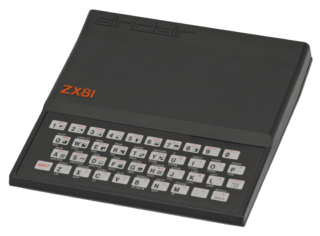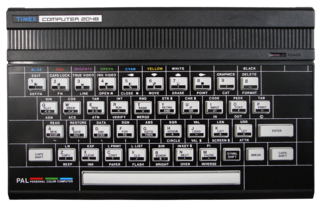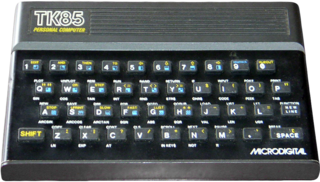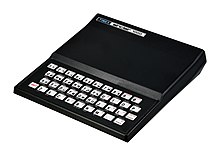
The Commodore 64, also known as the C64, is an 8-bit home computer introduced in January 1982 by Commodore International. It has been listed in the Guinness World Records as the highest-selling single computer model of all time, with independent estimates placing the number sold between 12.5 and 17 million units. Volume production started in early 1982, marketing in August for US$595. Preceded by the VIC-20 and Commodore PET, the C64 took its name from its 64 kilobytes(65,536 bytes) of RAM. With support for multicolor sprites and a custom chip for waveform generation, the C64 could create superior visuals and audio compared to systems without such custom hardware.

The Jupiter Ace by Jupiter Cantab was a British home computer released in 1982. The Ace differed from other microcomputers of the time in that its programming environment used Forth instead of the more popular BASIC. This difference, along with limited available software and poor character based graphic display, limited sales and the machine was not a success.

The Sinclair ZX80 is a home computer launched on 29 January 1980 by Science of Cambridge Ltd.. It is notable for being one of the first computers available in the United Kingdom for less than a hundred pounds. It was available in kit form for £79.95, where purchasers had to assemble and solder it together, and as a ready-built version at £99.95.

The ZX Spectrum is an 8-bit home computer developed and marketed by Sinclair Research. It is one of the most influential computers ever made, and also one of the best selling computers ever, with over five million units sold. It was first released in the United Kingdom on 23 April 1982, and around the world in the following years, most notably in Europe, the United States, and Eastern Bloc countries.

The ZX81 is a home computer that was produced by Sinclair Research and manufactured in Dundee, Scotland, by Timex Corporation. It was launched in the United Kingdom in March 1981 as the successor to Sinclair's ZX80 and designed to be a low-cost introduction to home computing for the general public. It was hugely successful; more than 1.5 million units were sold. In the United States it was initially sold as the ZX-81 under licence by Timex. Timex later produced its own versions of the ZX81: the Timex Sinclair 1000 and Timex Sinclair 1500. Unauthorized ZX81 clones were produced in several countries.
Sinclair BASIC is a dialect of the programming language BASIC used in the 8-bit home computers from Sinclair Research, Timex Sinclair and Amstrad. The Sinclair BASIC interpreter was written by Nine Tiles Networks Ltd.

The Timex Sinclair 2068, released in November 1983, was Timex Sinclair's third and last home computer for the United States market. It was also marketed in Canada, Argentina, Portugal and Poland, as Timex Computer 2068.

The VTech Laser 200 is an 8-bit home computer from 1983, also sold as the Salora Fellow, the Seltron 200 in Hungary and Italy, the Smart-Alec Jr. by Dynasty Computer Corporation in Dallas, Texas for the USA, the Texet TX8000A, and the Dick Smith VZ 200 and the VTech VZ 200.
Sinclair Research Ltd was a British consumer electronics company founded by Clive Sinclair in Cambridge. It was originally incorporated in 1973 as Westminster Mail Order Ltd, renamed Sinclair Instrument Ltd, then Science of Cambridge Ltd, then Sinclair Computers Ltd, and finally Sinclair Research Ltd. It remained dormant until 1976, when it was activated with the intention of continuing Sinclair's commercial work from his earlier company Sinclair Radionics, and adopted the name Sinclair Research in 1981.

3D Monster Maze is a survival horror computer game developed from an idea by J.K. Greye and programmed by Malcolm Evans and released in 1981 for the Sinclair ZX81 platform with the 16 KB memory expansion. The game was initially released by J. K. Greye Software in December 1981 and re-released in 1982 by Evans' own startup, New Generation Software. Rendered using low-resolution character block "graphics", it was one of the first 3D games for a home computer, and one of the first games incorporating typical elements of the genre that would later be termed survival horror.
Timex Sinclair was a joint venture established in December 1982 between the British company Sinclair Research and Timex Corporation in an effort to gain an entry into the rapidly growing early-1980s home computer market in North America.

The Timex Computer 2048 or TC 2048 is a 1984 computer developed by Timex Portugal, at the time part of Timex Sinclair. It was based on the Timex Sinclair 2048 prototype, with a similar redesign case, composite video output, Kempston joystick interface, and additional video modes, while being highly compatible with the Sinclair ZX Spectrum computer.

The TK85 was a ZX81 clone made by Microdigital Eletrônica, a computer company located in Brazil. It came with 16 or 48 KB RAM, and had a ZX Spectrum–style case, similar to a Timex Sinclair 1500.

The Lambda 8300 was a Sinclair ZX81 clone from Lambda Electronics Limited of Hong Kong. It had a modified ROM and extra hardware, making it not fully compatible. Total compatibility could be achieved by installing a ZX81 ROM.

The ZX Spectrum character set is the variant of ASCII used in the ZX Spectrum family computers. It is based on ASCII-1967 but the characters ^, ` and DEL are replaced with ↑, £ and ©. It also differs in its use of the C0 control codes other than the common BS and CR, and it makes use of the 128 high-bit characters beyond the ASCII range. The ZX Spectrum's main set of printable characters and system font are also used by the Jupiter Ace computer.

RAM pack, RAMpack, RAM expansion cartridge, RAM expansion unit (REU), memory expansion pak and memory module are some of the most common names given to various self-contained units or cartridges that expand a computer, games console or other device's own internal RAM in a user-friendly manner.

The ZX81 character set is the character encoding used by the Sinclair Research ZX81 family of microcomputers including the Timex Sinclair 1000 and Timex Sinclair 1500. The encoding uses one byte per character for 256 code points. It has no relationship with previously established ones like ASCII or EBCDIC, but it is related though not identical to the character set of the predecessor ZX80.
Tadeo Czerweny S.A. is an Argentinian manufacturer of transformers and other high-power electrical equipment founded by Tadeo Czerweny in 1958.

















